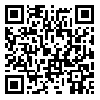Volume 11, Issue 2 (Winter 2026)
Health in Emergencies and Disasters Quarterly 2026, 11(2): 139-150 |
Back to browse issues page
Ethics code: IR. TBZMED.REC.1399.1079
Download citation:
BibTeX | RIS | EndNote | Medlars | ProCite | Reference Manager | RefWorks
Send citation to:



BibTeX | RIS | EndNote | Medlars | ProCite | Reference Manager | RefWorks
Send citation to:
Javanmardi K, Feizollahzadeh H, Gilani N, Dadashzadeh A, Dehghannejad J. Exposure Risk Assessment and Management of Pre-hospital Paramedics During the COVID-19 Pandemic. Health in Emergencies and Disasters Quarterly 2026; 11 (2) :139-150
URL: http://hdq.uswr.ac.ir/article-1-617-en.html
URL: http://hdq.uswr.ac.ir/article-1-617-en.html
Karim Javanmardi1 

 , Hosein Feizollahzadeh2
, Hosein Feizollahzadeh2 

 , Neda Gilani3
, Neda Gilani3 

 , Abbas Dadashzadeh *4
, Abbas Dadashzadeh *4 

 , Javad Dehghannejad2
, Javad Dehghannejad2 




 , Hosein Feizollahzadeh2
, Hosein Feizollahzadeh2 

 , Neda Gilani3
, Neda Gilani3 

 , Abbas Dadashzadeh *4
, Abbas Dadashzadeh *4 

 , Javad Dehghannejad2
, Javad Dehghannejad2 


1- Department of Medical Surgical Nursing, School of Nursing and Midwifery, Urmia University of Medical Sciences, Urmia, Iran.
2- Department of Medical Surgical Nursing, School of Nursing and Midwifery, Tabriz University of Medical Sciences, Tabriz, Iran.
3- Department of Statistics and Epidemiology, Faculty of Health, Tabriz University of Medical Sciences, Tabriz, Iran. & Medical Education Research Center, Health Management and Safety Promotion Research Institute, Tabriz University of Medical Sciences, Tabriz, Iran.
4- Department of Medical Surgical Nursing, School of Nursing and Midwifery, Tabriz University of Medical Sciences, Tabriz, Iran. ,ddshzd@yahoo.com
2- Department of Medical Surgical Nursing, School of Nursing and Midwifery, Tabriz University of Medical Sciences, Tabriz, Iran.
3- Department of Statistics and Epidemiology, Faculty of Health, Tabriz University of Medical Sciences, Tabriz, Iran. & Medical Education Research Center, Health Management and Safety Promotion Research Institute, Tabriz University of Medical Sciences, Tabriz, Iran.
4- Department of Medical Surgical Nursing, School of Nursing and Midwifery, Tabriz University of Medical Sciences, Tabriz, Iran. ,
Abstract: (860 Views)
Background: Pre-hospital paramedics providing immediate care to patients with contagious disease are at a high risk of infection. This study aimed to assess the exposure risk and risk management practices of pre-hospital paramedics during the COVID-19 pandemic.
Materials and Methods: A cross-sectional study was conducted among 335 paramedics from 49 emergency medical stations in two cities located in northwestern of Iran, who were recruited through census. Data were collected using a World Health Organization (WHO) questionnaire to assess the COVID-19 exposure risk among health workers.
Results: The results showed that the highest risk of exposure (86.0%) was in the domain of occupational exposure, and 55.2% of paramedics were at high risk of exposure to COVID-19. Among paramedics, 95.2% used personal protective equipment (PPE) when caring for patients and 93.1% when performing aerosol-generating procedures.
Conclusion: A significant number of pre-hospital paramedics were found to be at high exposure risk to COVID-19 during ambulance missions. Therefore, adherence to contact and droplet precautions, implementation of airborne precautions during aerosol-generating procedures, access to appropriate PPE, proper use of PPE, and participation in appropriate training courses may lead to improved exposure risk management and enhance their safety.
Materials and Methods: A cross-sectional study was conducted among 335 paramedics from 49 emergency medical stations in two cities located in northwestern of Iran, who were recruited through census. Data were collected using a World Health Organization (WHO) questionnaire to assess the COVID-19 exposure risk among health workers.
Results: The results showed that the highest risk of exposure (86.0%) was in the domain of occupational exposure, and 55.2% of paramedics were at high risk of exposure to COVID-19. Among paramedics, 95.2% used personal protective equipment (PPE) when caring for patients and 93.1% when performing aerosol-generating procedures.
Conclusion: A significant number of pre-hospital paramedics were found to be at high exposure risk to COVID-19 during ambulance missions. Therefore, adherence to contact and droplet precautions, implementation of airborne precautions during aerosol-generating procedures, access to appropriate PPE, proper use of PPE, and participation in appropriate training courses may lead to improved exposure risk management and enhance their safety.
Type of article: Research |
Subject:
Risk assessment
Received: 2024/11/8 | Accepted: 2025/04/23 | Published: 2026/01/1
Received: 2024/11/8 | Accepted: 2025/04/23 | Published: 2026/01/1
Send email to the article author
| Rights and permissions | |
 |
This work is licensed under a Creative Commons Attribution-NonCommercial 4.0 International License. |





